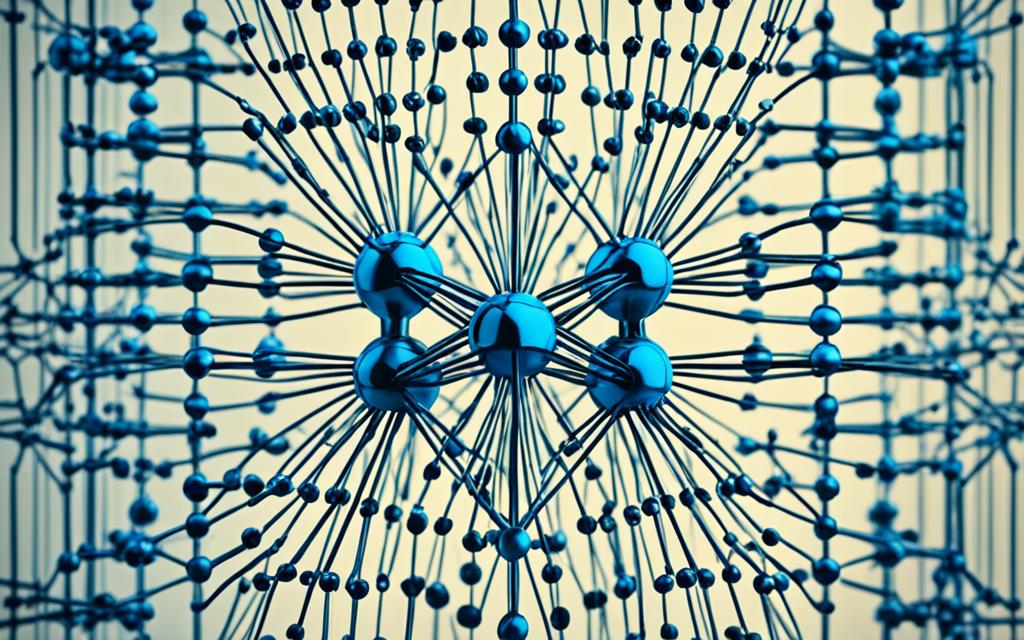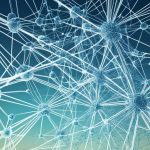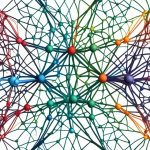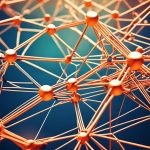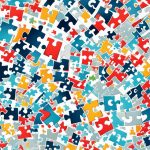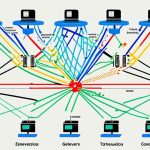We’re diving into the latest in quantization methods to boost neural network inference efficiency. Quantization means changing continuous numbers into a limited set to save memory and cut down on computing power. It’s super important now because Neural Networks do so well in things like computer vision and understanding language. By switching to low-precision values, we can make things run faster and use less memory. This piece will give you the lowdown on quantization for neural networks, including the good and bad of each method1.
Key Takeaways:
- Quantization is a process that distributes continuous real-valued numbers over a fixed discrete set to reduce memory and computational requirements1
- Neural network quantization aims to enhance efficiency by using low-precision fixed integer values1
- Quantization plays a crucial role in computer vision and natural language processing applications1
- Various quantization methods will be explored in this article1
- Understanding the advantages and disadvantages of current quantization techniques is essential for optimizing neural network inference1
The Problem of Quantization
Quantization is key in making numbers fit into a limited set for easier handling and sharing. It’s vital when we’re short on memory or need quick calculations. In neural networks, it helps shrink memory use and speed up tasks, making it great for when resources are tight.
By changing floating-point numbers to simple integers, quantization can cut memory and speed by up to 16 times2. This means we can see memory use drop by 4 to 8 times2. This is super useful in tasks like seeing images or understanding language, where big neural networks are often used.
Quantization has its downsides, though. It can make some numbers less accurate2. But, dynamic quantization can fix this by adjusting settings during use, giving better results but using more power2.
Choosing the right quantization level is also important. This affects how the network works and how well it does its job. There are two main ways to do this: layerwise and channelwise quantization2.
To improve quantization, we’ve come up with new ways to do it. Quantization Aware Training (QAT) adjusts the model after quantizing it. QAT uses tricks to make calculations easier2. Post Training Quantization (PTQ) doesn’t need retraining but might not be as precise2.
Simulated quantization uses less precise storage but still does math with floating-point numbers. This is good for saving bandwidth2. Integer-only quantization does everything with whole numbers, making it fast2. Dyadic quantization uses rational numbers that make math easier and faster2.
For better quantization, we look at how hardware works. This helps speed up the process by using what the hardware can do best2.
Quantization is a big deal in making neural networks work better. We’ll look at why it’s important, the different ways to do it, and the latest and future ideas in this area.
Importance of Quantization in Neural Network Inference
Neural Network models are doing great in computer vision and natural language processing. Quantization helps make these models work better by using less memory and speeding up operations. By changing floating-point numbers to simple integers, we can save a lot of memory3.
Quantization can cut memory use and speed by 4x to 8x4. This is great for devices with limited resources. It lets us use deep neural networks on these devices for fast, real-time tasks5.
Quantization also makes neural networks run faster, which is key for quick decisions. It cuts down on the complex math needed, making things faster and cheaper3.
Quantization works by using fewer bits for the weights in a neural network, which saves a lot of work3.
Quantization also saves energy. It uses less memory and does less work, which means less power and energy use. This is super useful for devices that need to last a long time or work in places with limited power4.
Quantization helps many industries like self-driving cars, robots, and healthcare. It makes it possible to use complex AI models in real-time, opening up new possibilities5.
Advantages of Quantization in Neural Network Inference
Quantization has many benefits for neural network inference, including:
- Less memory needed: By using less precise numbers, models take up much less space4.
- Quicker inference: Fewer calculations mean faster results, perfect for quick decisions3.
- Less energy used: It helps save power, which is great for devices that need to last a long time or work in places with limited power4.
- Works well on edge devices: It’s perfect for devices with limited resources, like smartphones or smart home devices5.
- Keeps performance high: Even with less memory and fewer calculations, quantized models can still work really well5.
The Role of Quantization in Neural Network Optimization
Quantization is key to making neural networks better. It works well with other methods like pruning and compression to save even more memory and work without losing performance4.
NVIDIA’s TensorRT uses quantization to speed up and save memory for neural networks. This makes it possible to run complex models on many devices and platforms5.
As we keep improving quantization, we’ll get even better networks for all kinds of applications5.
Researchers are always finding new ways to make quantization better. They’re working on new algorithms and tools to make quantized networks more efficient and accurate4.
Quantization is changing how we use neural networks. It makes them more efficient, compact, and ready for devices with limited resources and real-time needs. As we keep improving, we’ll see even more benefits in many industries4.
Summary
Quantization is a big deal for making neural networks work better. It saves memory, cuts down on wait time, and uses less energy. With ongoing research, we’re finding new ways to make quantized networks even better. This could change how we use AI in many areas5.
Surveying Quantization Approaches for Neural Networks
We will look at different ways to make neural networks smaller and faster. This is called quantization. It’s key for making AI models work better on devices with less power. Quantization makes models smaller and faster but has its own challenges.
Quantization changes the way data moves in a neural network, making it use fewer bits. This makes the model smaller and easier to work with. But, it might make the model less accurate, which is something to think about6.
Extreme quantization goes further by using just 1-bit for some parts of the network. This makes the network use much less memory and do fewer calculations6.
Some methods combine quantization with pruning. Pruning cuts out parts of the network that aren’t needed. This makes the network use less memory and work faster6.
Another way to make the network smaller is by using tensor decomposition. This turns complex data into simpler forms without losing too much performance6.
Knowledge distillation is a method where a smaller model learns from a bigger one. This lets us use smaller models that work almost as well6.
Quantization is great for using neural networks on devices with limited power. These networks have a lot of parts, making them hard to run on small devices. Quantization helps by making these parts less precise, which makes the network run better7.
Quantization has been around since the 1990s but is getting more attention now. This is because we need to make complex AI models work on devices like smartphones7.
Researchers have found many ways to make neural networks use less bits. These include using integers, binary, or mixed precision. Each method has its own balance of precision and efficiency7.
Working on making hardware better for quantized neural networks is key. By making the parts of the network less precise, we can make devices work more efficiently and save money7.
There’s still a lot to explore in making neural networks work better with less precision. Researchers are always finding new ways to improve and overcome challenges. This shows how important quantization is for making AI work better on devices7.
Summary of Quantization Approaches
| Approach | Advantages | Disadvantages |
|---|---|---|
| Quantization | – Reduced model size – Simplified operations – Efficient deployment on edge devices |
– Trade-off between precision and performance |
| Extreme Quantization (Binarization) | – Significantly reduced memory and computation requirements | – Further loss of precision and potential impact on accuracy |
| Quantization + Pruning | – Enhanced memory access and computation performance | – Loss of certain network properties and potential accuracy trade-offs |
| Tensor Decomposition | – Reduction of parameters and memory usage | – Trade-off between compression and model performance |
| Knowledge Distillation | – Deployment of smaller, more lightweight models | – Relying on a larger teacher model for transferring knowledge |
Table: Summary of quantization approaches and their advantages and disadvantages.
Quantization Methods for Efficient Neural Network Inference
Efficient neural network inference is key to speeding up AI and cutting down on the resources needed for deep learning models. To make inference faster, techniques like quantization are widely used and studied.
Quantization means making the weights and activations in a neural network less precise. This cuts down on memory use and speeds up calculations, making it great for real-time and low-resource tasks. There are many quantization methods, each with its own strengths and weaknesses.
Fixed-Point Quantization
Fixed-point quantization is a common way to lower the precision of neural network weights and activations. It uses a fixed number of bits to represent numbers, often as integers instead of floating-point numbers. This reduces memory use, making inference more efficient.
Integer Quantization
Integer quantization gives integer values to the continuous numbers in a neural network. It works well because most weights and activations can be close enough to integers. This method is great for fast, low-latency inference, using less memory and computing faster.
Mixed-Precision Quantization
Mixed-precision quantization is a more advanced method that adjusts the precision of different layers or neurons. It tries to keep performance high while saving a lot of resources. By balancing precision needs across layers, it makes memory use and computation faster.
Using these quantization methods makes neural network inference more efficient without losing performance. This means AI can work well on devices with limited resources, like edge devices and IoT devices.
As AI grows, techniques like quantization will be key to making neural network inference more efficient. Researchers are always finding new ways to improve quantization, making neural networks work better and use less resources.
Next, we’ll look at the latest in quantization techniques in Section 6 and talk about their benefits and downsides in Section 7. Stay tuned!
State-of-the-Art Techniques for Quantization
Today’s best methods for quantization aim to get top accuracy with simple networks that use less computation, memory, and power. These methods are key to making neural networks work better by cutting down the precision of network parameters without losing accuracy.
Two big methods for choosing layer precision are Entropy Approximation Guided Layer selection (EAGL) and Accuracy-aware Layer Precision Selection (ALPS)7. EAGL uses the entropy of weight distribution to figure out how changing layer precision affects performance. ALPS picks precision based on the task’s needs and fine-tunes after precision reduction. These new ways help make quantization more efficient and help get full-precision accuracy with fewer bits for layers.
Recent studies show that combining EAGL and ALPS works well for networks like ResNet-50, ResNet-101, and BERT-base transformer networks7. Mixing 4-bit and 2-bit layers, chosen for their impact on performance, has shown great results. This has greatly improved performance across the accuracy-throughput frontier, beating current methods in time to solve problems7.
By focusing on layer precision, researchers are unlocking quantization’s potential to make neural network inference more efficient without losing accuracy. These top techniques offer real solutions for finding the best balance between precision and resource use in applications like computer vision and natural language processing.
Table: Comparative Analysis of State-of-the-Art Techniques for Quantization
| Technique | Advantages | Challenges |
|---|---|---|
| EAGL and ALPS7 | Enables full-precision accuracy with lower bit representations of layers | Requires careful selection of layers based on their impact on overall performance |
| Quantization-aware training | Allows for end-to-end optimization of quantized models | Increases computational complexity during training |
| Weight clustering | Reduces memory footprint and improves hardware efficiency | May introduce additional quantization error |
Quantization techniques are getting better, making neural network inference more efficient. Researchers are making big strides to overcome challenges and unlock quantization’s full potential. These advances are very promising for making complex networks more widely used while saving time, memory, and power.
Reference:
7 Statistical data extracted from Link 1.
Benefits and Limitations of Quantization Methods
Quantization methods make neural networks work better and use less memory. They are key to making AI models more efficient. But, it’s important to know their limits too.
Benefits of Quantization Methods
Quantization greatly reduces memory use, making it easier to run neural networks on devices with limited resources8. By using fewer bits, memory and speed can drop by 16 times8. In real use, like in computer vision and language processing, models can be 4 to 8 times faster8.
Quantization is a big deal in making neural networks work better and faster8. It helps make AI models use less memory and run faster, making them more useful.
Quantization has been a big win for both training and using neural networks8. Recent advances have made AI accelerators work much faster8.
Limitations of Quantization Methods
Quantization has its downsides too. It might make tasks less accurate, but this is usually small if done right8.
The type of quantization and how precise it is can affect how well a model works9. Some methods might make models less accurate9. It’s important to weigh the benefits against the loss in performance and memory use.
Post-training quantization can be tricky, especially for precise models or complex tasks10. But, it’s still a good choice for making models use less memory and run faster without retraining10.
Summary Table: Benefits and Limitations of Quantization Methods
| Benefits | Limitations |
|---|---|
|
|
Advancements in Quantization Research
Quantization research is growing fast, finding new ways to make neural network inference more efficient11. Researchers are working hard to solve problems like memory use, how complex the calculations are, and how to keep accuracy high. These efforts are key to making quantization work well in real life.
New algorithms are being developed to keep accuracy high when reducing the precision of neural networks11. These better algorithms let quantized models keep their performance while using less memory and less power. This means we can use neural networks on devices with limited resources without losing performance.
Improvements in network designs are also helping quantization work better1112. New designs are made to work well with lower precision, making neural networks use less memory and run faster12. These designs are made to make the most of quantized models, leading to better performance and saving energy.
Researchers are also focusing on fine-tuning strategies11128. Techniques like post-training quantization (PTQ) and quantization-aware training (QAT) are proving effective in closing the gap between full-precision and quantized models11. PTQ is great for quick deployment, needing less tuning and training12. QAT trains networks with simulated quantization during training, leading to better accuracy with less precision1112. These strategies could change how we use neural networks, making them more efficient and accurate.
Advancements in Optimization Algorithms:
Improvements in optimization algorithms are key to better quantization methods11. Researchers are creating algorithms that reduce accuracy loss during quantization, keeping quantized models performing well11. This means we can use neural networks with 8-bit precision, saving memory and power without losing accuracy11. This opens up more possibilities for using neural networks in various applications.
Novel Architectural Designs:
Researchers are looking into new architectural designs for better quantized neural networks12. These designs consider the special needs of low-precision formats, leading to efficient computation and better accuracy12. By designing networks with quantization in mind, researchers have made big strides in memory use, speed, and efficiency12. This could lead to wider use of quantized neural networks in places with limited resources.
Improved Fine-Tuning Strategies:
Strategies like post-training quantization (PTQ) and quantization-aware training (QAT) have gotten better11128. PTQ is good for quick deployment, needing less tuning and training12. QAT trains networks with simulated quantization, leading to better accuracy with less precision1112. These strategies help bridge the gap between full-precision and quantized models, ensuring quantized models perform as well as their full-precision counterparts1112.
In conclusion, advances in quantization research are leading to more efficient and accurate neural network inference methods11128. Through better algorithms, new designs, and fine-tuning strategies, researchers are pushing the limits of quantization. This makes it a key method for efficient and effective neural network inference in many applications.
| Advancements in Quantization Research | Reference |
|---|---|
| Optimization Algorithms | 11 |
| Novel Architectural Designs | 12 |
| Fine-Tuning Strategies | 1112 |
Future Directions and Impact of Quantization in AI
Quantization for neural network inference is a hot topic in research. There are many promising areas to explore. For example, creating special hardware for these networks could boost performance and efficiency13. Another area is using hybrid quantization, which blends low-precision and full-precision methods7.
As AI becomes more widespread, quantization will greatly impact the AI world7. It makes AI faster and uses less energy. This could lead to big changes in healthcare, self-driving cars, and robots8.
Specialized Hardware for Quantized Neural Networks
Quantization is getting more popular, so we need special hardware to make the most of it. This hardware can make the quantization process better, improving how fast and efficient AI works. By using the unique features of quantized networks, like needing less memory and being faster, we can make AI even better13.
Hybrid Quantization Techniques
Hybrid quantization is an exciting new area. It combines the best of low-precision and full-precision methods for better neural network performance7. By mixing different quantization levels for weights and activations, we can get more flexibility and accuracy in AI models.
Tools like TFlite and Pytorch make it easier to use quantization. They let researchers and developers pick the best quantization methods for their models13. As AI gets more complex, hybrid quantization could open up new possibilities and drive more progress in AI7.
| Data Reduction | Quantization Methodology | Application |
|---|---|---|
| 16x | Low-precision fixed integer values represented in four bits or less | Memory footprint and latency reduction |
| 4x to 8x | Quantization methodologies | Computer vision and natural language processing applications |
| ≥4× compression | Quantization alone | Maintaining performance and achieving high compression ratios |
Quantization is not just about saving memory and improving efficiency. It’s also about finding the right balance between accuracy and performance. Techniques like mixed precision quantization have shown great results, especially in efficient models like EfficientNet and MobileNet13. Researchers are always finding new ways to make quantization better, like weight equalization to reduce variance in weights13.
There are two main methods used in the industry: Post Training Quantization (PTQ) and Quantization-Aware Training (QAT). PTQ is quick and works well with limited resources13. QAT can help improve accuracy but needs more computing power13.
Having good quantization tools is key to making quantization work well. Tools like TFlite and Pytorch support quantization well, making it easier for people to use and improve quantization methods for their models13.
Convergence of Quantization and AI Advancements
Quantization and AI advancements are coming together, creating a positive cycle. Better quantization means faster and more efficient AI, which leads to more research in quantization8. This cycle drives innovation, leading to big changes in fields where AI is important.
Quantization also helps AI work better in places with limited resources. It reduces memory use, energy, and speed, making AI useful in tasks like speech recognition, self-driving cars, and image classification7. This makes AI more accessible and useful on devices and systems without much power.
Future Implications
The future of quantization in AI looks exciting. We’ll see better and more accurate quantization methods, new hardware, and tools. These will let us use AI in more complex ways, keeping it efficient and accurate.
In summary, the future of quantization in AI is bright. With new hardware and techniques, quantized neural networks will change how AI works in many areas. As research goes on, we can expect big changes that will shape the future of AI.
Conclusion
Efficient neural network inference depends on using quantization methods. These include fixed-point, integer, and mixed-precision quantization. They help reduce memory use and speed up AI tasks14.
Advanced quantization techniques like EAGL and ALPS perform better than before, showing great results14. Changing 32-bit weights to 8-bit can cut memory use by four times15. This leads to smaller models and better accuracy in neural networks15. Also, using fewer bits for weights, activations, or gradients speeds up training and use14.
Research is always improving how efficient and accurate quantization is14. Quantization could change many industries and bring new uses14. Tools like PolyThrottle help save energy in neural network use on edge devices16. PolyThrottle is easy to fine-tune and can predict performance well, making it a great way to save energy and meet speed goals16.
FAQ
What is quantization?
Quantization turns continuous real numbers into a fixed set of numbers. This makes it easier to store and process data.
Why is quantization important in neural network inference?
It’s key because it cuts down on memory and speed, making things run faster and use less power without losing performance.
What are some popular quantization methods?
Popular ways include using fixed-point numbers, whole numbers, and a mix of both for quantization.
What are the advantages and disadvantages of quantization methods?
The good parts are it saves memory and speeds things up. The not-so-good part is it might slightly lower performance.
What are state-of-the-art techniques for quantization?
Top methods now use Entropy Approximation Guided Layer selection (EAGL) and Accuracy-aware Layer Precision Selection (ALPS).
What are the benefits and limitations of quantization methods?
The upsides are less memory use and faster speeds. The downsides are a bit less performance.
What advancements are being made in quantization research?
Researchers are working on better algorithms, network designs, fine-tuning, and training methods for quantization.
What are some future directions for quantization in AI?
The future looks at new hardware and hybrid methods for quantization.
Source Links
- https://www.mdpi.com/2227-7390/11/9/2112 – Neuron-by-Neuron Quantization for Efficient Low-Bit QNN Training
- https://velog.io/@dudtls11444/Paper-Review-A-Survey-of-Quantization-Methods-for-Efficient-Neural-Network-Inference-2021 – [Paper Review] A Survey of Quantization Methods for Efficient Neural Network Inference (2021)
- https://www.sciencedirect.com/science/article/abs/pii/S1063520323000337 – A simple approach for quantizing neural networks
- https://www.mdpi.com/2079-9292/13/9/1727 – Quantization-Based Optimization Algorithm for Hardware Implementation of Convolution Neural Networks
- https://www.activeloop.ai/resources/glossary/quantization/ – What is Quantization
- https://www.mdpi.com/2079-9292/11/6/945 – A Survey on Efficient Convolutional Neural Networks and Hardware Acceleration
- https://arxiv.org/pdf/2112.06126 – Neural Network Quantization for Efficient Inference: A Survey
- https://ar5iv.labs.arxiv.org/html/2103.13630 – A Survey of Quantization Methods for Efficient Neural Network Inference
- https://velog.io/@thdalwh3867/A-Survey-of-Quantization-Methods-for-EfficientNeural-Network-Inference – A Survey of Quantization Methods for Efficient Neural Network Inference
- https://medium.com/@jan_marcel_kezmann/master-the-art-of-quantization-a-practical-guide-e74d7aad24f9 – Master the Art of Quantization: A Practical Guide
- https://medium.com/@gannongonzo/quantization-in-machine-learning-08d129681907 – Quantization in Machine Learning
- https://medium.com/@aruna.kolluru/mastering-quantization-techniques-for-optimizing-large-language-models-b5bf5f5a3196 – Mastering Quantization Techniques for Optimizing Large Language Models
- https://www.edge-ai-vision.com/2024/04/quantization-of-convolutional-neural-networks-quantization-analysis/ – Quantization of Convolutional Neural Networks: Quantization Analysis
- https://ar5iv.labs.arxiv.org/html/1808.04752 – A Survey on Methods and Theories of Quantized Neural Networks
- https://medium.com/@anhtuan_40207/introduction-to-quantization-09a7fb81f9a4 – Introduction to Quantization
- https://hackernoon.com/polythrottle-energy-efficient-neural-network-inference-on-edge-devices-conclusion-and-references – PolyThrottle: Energy-efficient Neural Network Inference on Edge Devices: Conclusion & References | HackerNoon

